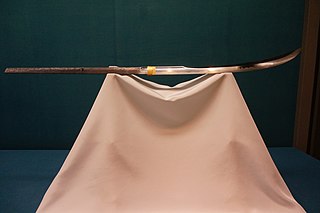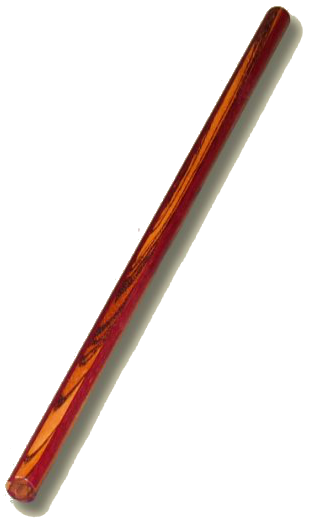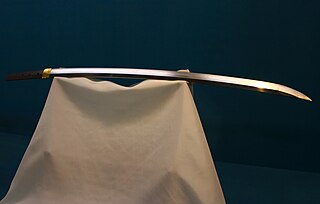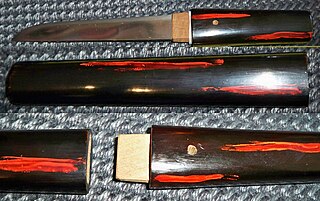Related Research Articles
A bokken is a Japanese wooden sword used for training in kenjutsu. It is usually the size and shape of a katana, but is sometimes shaped like other swords, such as the wakizashi and tantō. Some ornamental bokken are decorated with mother-of-pearl work and elaborate carvings. Sometimes it is spelled "boken" in English.

A Japanese sword is one of several types of traditionally made swords from Japan. Bronze swords were made as early as the Yayoi period, though most people generally refer to the curved blades made from the Heian period (794–1185) to the present day when speaking of "Japanese swords". There are many types of Japanese swords that differ by size, shape, field of application and method of manufacture. Some of the more commonly known types of Japanese swords are the uchigatana, tachi, ōdachi, wakizashi, and tantō.
A sword is an edged, bladed weapon intended for manual cutting or thrusting. Its blade, longer than a knife or dagger, is attached to a hilt and can be straight or curved. A thrusting sword tends to have a straighter blade with a pointed tip. A slashing sword is more likely to be curved and to have a sharpened cutting edge on one or both sides of the blade. Many swords are designed for both thrusting and slashing. The precise definition of a sword varies by historical epoch and geographic region.
A tsurugi (剣) or ken (剣) is a Japanese sword. The word is used in the West to refer to a specific type of Japanese straight, double-edged sword used in antiquity. In Japanese the term tsurugi or ken is used as a term for all sorts of international long, double-edged swords.
A tachi is a type of sabre-like traditionally made Japanese sword (nihonto) worn by the samurai class of feudal Japan. Tachi and uchigatana generally differ in length, degree of curvature, and how they were worn when sheathed, the latter depending on the location of the mei (銘), or signature, on the tang. The tachi style of swords preceded the development of the katana, which was not mentioned by name until near the end of the twelfth century. Tachi were the mainstream Japanese swords of the Kotō period between 900 and 1596. Even after the Muromachi period (1336–1573), when katana became the mainstream, tachi were often worn by high-ranking samurai.

The wakizashi is one of the traditionally made Japanese swords worn by the samurai in feudal Japan. Its name refers to the practice of wearing it inserted through one's obi or sash at one's side, whereas the larger tachi sword was worn slung from a cord.

The daishō—"big-little"—is a Japanese term for a matched pair of traditionally made Japanese swords (nihonto) worn by the samurai class in feudal Japan.

The naginata is a polearm and one of several varieties of traditionally made Japanese blades (nihontō). Naginata were originally used by the samurai class of feudal Japan, as well as by ashigaru and sōhei. The naginata is the iconic weapon of the onna-musha, a type of female warrior belonging to the Japanese nobility. A common misconception is that the Naginata is a type of sword, rather than a polearm.

A tantō is one of the traditionally made Japanese swords that were worn by the samurai class of feudal Japan. The tantō dates to the Heian period, when it was mainly used as a weapon but evolved in design over the years to become more ornate. Tantō were used in traditional martial arts. The term has seen a resurgence in the West since the 1980s as a point style of modern tactical knives, designed for piercing or stabbing.

The hanbō is a staff used in martial arts. Traditionally, the hanbō was approximately three shaku or about 90 centimetres (35 in) long, half the length of the usual staff, the rokushakubō. Diameter was 2.4 to 3 centimetres. However, depending on the school the length and diameter varied.

The ōdachi (大太刀) or nodachi is a type of traditionally made Japanese sword used by the samurai class of feudal Japan. The Chinese equivalent of this type of sword in terms of weight and length is the miaodao or the earlier zhanmadao, and the Western battlefield equivalent is the Zweihänder.

Japanese sword mountings are the various housings and associated fittings that hold the blade of a Japanese sword when it is being worn or stored. Koshirae (拵え) refers to the ornate mountings of a Japanese sword used when the sword blade is being worn by its owner, whereas the shirasaya is a plain undecorated wooden mounting composed of a saya and tsuka that the sword blade is stored in when not being used.
The katana sword appears in many folk tales as well as legends. This piece of Japanese history not only appears in old folklore, it is also very popular in modern fiction as well as contemporary art pieces such as film and theater. The katana has reached far and wide in the world of fictional stories and can be used to tell tales of wisdom and bravery or evil and treachery. The sword can be seen not only as a tool for the hero but also a tool for the villain.

The Kogarasu Maru (小烏丸), or "Little Crow Circle", is a unique Japanese tachi sword believed to have been created by legendary Japanese smith Amakuni during the 8th century AD.

A katana is a Japanese sword characterized by a curved, single-edged blade with a circular or squared guard and long grip to accommodate two hands. Developed later than the tachi, it was used by samurai in feudal Japan and worn with the edge facing upward. Since the Muromachi period, many old tachi were cut from the root and shortened, and the blade at the root was crushed and converted into a katana. The specific term for katana in Japan is uchigatana (打刀) and the term katana (刀) often refers to single-edged swords from around the world.

A kaiken is a 20–25 cm (7.9–9.8 in) long, single or double-edged Japanese knife usually without ornamental fittings housed in a plain but lacquered mount.
The banyal, is a short sword originating in the Moro people of Mindanao in the Philippines. It has an unusual concave shape on the blade's top part, which is very similar to the bangkung in general profile. But it is smaller with a different pommel style. The blade is thick, weighted at the front for chopping attacks and had a single edge.
The batangas or batangas malapad, is a sword originating from the Tagalog people of the Philippines. It is a type of bolo that widens near the tip. It is around 24 to 28 in long with a hooked hilt grip.
Utak is a traditional Filipino ethnic Moro weapon in the Sulu Archipelago. It is a sword with a wide tip designed for cutting forward and is a one-handed weapon meant for chopping. The sword is about 24–48 in (61–122 cm) in length with a hooked grip to prevent slipping when wet.
Laring is one of the traditional ethnic Moro weapons of Southern Philippines. It has a lightweight design for slashing and thrusting. It has a two pronged tip like a blade catcher that looks like a snake's tongue. The blade guard has a small round steel for firmer hold and mobility. The handle end has a unique hooked hilt grip design that serves as a counter weight for better handling and balance and to prevent the sword from slippage when pulling out when stuck in a target.
References
- ↑ "SAMURAI KATANA SWORD PHILIPPINES". SAMURAI KATANA SWORD PHILIPPINES. Retrieved 20 December 2021.
- ↑ Draeger, Donn F.; Smith, Robert W. (1980). Comprehensive Asian Fighting Arts. Kodansha International. p. 186. ISBN 9780870114366 . Retrieved 30 September 2019.
- ↑ Lawrence, Marc. "Filipino Weapons from A-Z" (PDF). Steven K. Dowrd. Archived from the original (PDF) on 24 August 2014. Retrieved 20 December 2021.
- ↑ Lawrence, Mark. "Filipino Martial Arts Digest" (PDF). USADojo.com. Retrieved 20 December 2021.